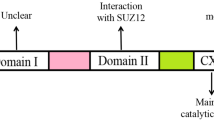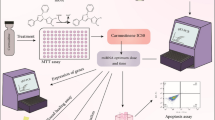Abstract
A previous report suggested that the expression of ten-eleven translocation (TET) proteins is abnormal in certain cancers. Quercetin has been demonstrated as anti-cancer role in cancer development. In order to explore the inhibitory effect and mechanism of quercetin on uveal melanoma cells, the expression of TET proteins was analyzed in the present study. Our results suggest that the expression of TET1 was increased following treatment with quercetin in OCM-1, SK-MEL-1, and B16 cells. In addition, quercetin treatment induced apoptosis and inhibited migration and invasion. To further investigate the association of the expression of TET1 with cell growth, apoptosis, migration, and invasion, cell lines in which TET1 was knocked-down or overexpressed were constructed. The results showed that the increased expression of TET1-induced apoptosis, increased 5-hydroxymethylcytosine (5 hmC). and inhibited invasion. Our bioinformatics studies indicated that TET1 is a target gene of microRNA-17 (miR-17) Our results showed that inhibition of the expression of miR-17 resulted in increased TET1 expression in OCM-1 cells. Furthermore, our results indicated that quercetin treatment increased TET1 expression and inhibited melanoma growth in nude mice. Taken together, our results suggest that quercetin can regulate cell proliferation and apoptosis through TET1 via miR-17 in melanoma cells.








Similar content being viewed by others
Data Availability
All data generated or analyzed during this study are included in this published article [and its supplementary information files].
References
Alavi M, Adulrahman NA, Haleem AA, Al-Râwanduzi ADH, Khusro A, Abdelgawad MA, Ghoneim MM, Batiha GE-S, Kahrizi D, Martinez F, Koirala N (2022) Nanoformulations of curcumin and quercetin with silver nanoparticles for inactivation of bacteria. Cell Mol Biol 67(5):151–156. https://doi.org/10.14715/cmb/2021.67.5.21
Chen L, Li Q, Jiang Z, Li C, Hu H, Wang T, Gao Y, Wang D (2021) Chrysin induced cell apoptosis through H19/let-7a/COPB2 axis in gastric cancer cells and inhibited tumor growth. Front Oncol 11:651644. https://doi.org/10.3389/fonc.2021.651644
de Oliveira MR, Nabavi SM, Braidy N, Setzer WN, Ahmed T, Nabavi SF (2016) Quercetin and the mitochondria: a mechanistic view. Biotechnol Adv 34(5):532–549. https://doi.org/10.1016/j.biotechadv.2015.12.014
Ding C, Li L, Yang T, Fan X, Wu G (2016) Combined application of anti-VEGF and anti-EGFR attenuates the growth and angiogenesis of colorectal cancer mainly through suppressing AKT and ERK signaling in mice model. BMC Cancer 16(1):791. https://doi.org/10.1186/s12885-016-2834-8
Gao M, Tang J, Liu K, Yang M, Liu H (2018) Quantitative evaluation of vascular microcirculation using contrast-enhanced ultrasound imaging in rabbit models of choroidal melanoma. Invest Ophthalmol vis Sci 59(3):1251–1262. https://doi.org/10.1167/iovs.17-22197
Guo H, Zhu H, Zhang J, Wan B, Shen Z (2019) TET1 suppresses colon cancer proliferation by impairing beta-catenin signal pathway. J Cell Biochem. https://doi.org/10.1002/jcb.28522
Harris Z, Donovan MG, Branco GM, Limesand KH, Burd R (2016) Quercetin as an emerging anti-melanoma agent: a four-focus area therapeutic development strategy. Front Nutr 3:48. https://doi.org/10.3389/fnut.2016.00048
He YF, Li BZ, Li Z, Liu P, Wang Y, Tang QY, Ding JP, Jia YY, Chen ZC, Li L, Sun Y, Li XX, Dai Q, Song CX, Zhang KL, He C, Xu GL (2011) Tet-mediated formation of 5-carboxylcytosine and its excision by TDG in mammalian DNA. Science 333(6047):1303–1307. https://doi.org/10.1126/science.1210944
Huang Y, Rao A (2014) Connections between TET proteins and aberrant DNA modification in cancer. Trends Genet 30(10):464–474. https://doi.org/10.1016/j.tig.2014.07.005
Khan I, Paul S, Jakhar R, Bhardwaj M, Han J, Kang SC (2016) Novel quercetin derivative TEF induces ER stress and mitochondria-mediated apoptosis in human colon cancer HCT-116 cells. Biomed Pharmacother 84:789–799. https://doi.org/10.1016/j.biopha.2016.09.094
Kocyigit A, Guler EM (2017) Curcumin induce DNA damage and apoptosis through generation of reactive oxygen species and reducing mitochondrial membrane potential in melanoma cancer cells. Cell Mol Biol 63(11):97–105. https://doi.org/10.14715/cmb/2017.63.11.17
Lai H, Zhang J, Zuo HQ, Liu HZ, Xu J, Feng Y, Lin Y, Mo XW (2020) Overexpression of miR-17 is correlated with liver metastasis in colorectal cancer. Medicine. https://doi.org/10.1097/MD.0000000000019265
Li R, Zhou Y, Cao Z, Liu L, Wang J, Chen Z, Xing W, Chen S, Bai J, Yuan W, Cheng T, Xu M, Yang FC, Zhao Z (2018) TET2 Loss dysregulates the behavior of bone marrow mesenchymal stromal cells and accelerates Tet2(-/-)-driven myeloid malignancy progression. Stem Cell Reports 10(1):166–179. https://doi.org/10.1016/j.stemcr.2017.11.019
Li Y, He J, Qiu C, Shang Q, Qian G, Fan X, Ge S, Jia R (2019) The oncolytic virus H101 combined with GNAQ siRNA-mediated knockdown reduces uveal melanoma cell viability. J Cell Biochem 120(4):5766–5776. https://doi.org/10.1002/jcb.27863
Massi A, Bortolini O, Ragno D, Bernardi T, Sacchetti G, Tacchini M, De Risi C (2017) Research progress in the modification of quercetin leading to anticancer agents. Molecules. https://doi.org/10.3390/molecules22081270
Nesvet J, Rizzi G, Wang SX (2019) Highly sensitive detection of DNA hypermethylation in melanoma cancer cells. Biosens Bioelectron 124–125:136–142. https://doi.org/10.1016/j.bios.2018.10.018
Orgaz JL, Sanz-Moreno V (2013) Emerging molecular targets in melanoma invasion and metastasis. Pigment Cell Melanoma Res 26(1):39–57. https://doi.org/10.1111/pcmr.12041
Shi YP, Liu GL, Li S, Liu XL (2020) miR-17-5p knockdown inhibits proliferation, autophagy and promotes apoptosis in thyroid cancer via targeting PTEN. Neoplasma 67(2):249–258. https://doi.org/10.4149/neo_2019_190110N29
Shi ZH, Li NG, Tang YP, Shi QP, Zhang W, Zhang PX, Dong ZX, Li W, Zhang X, Fu HA, Duan JA (2014) Synthesis, biological evaluation and SAR analysis of O-alkylated analogs of quercetin for anticancer. Bioorg Med Chem Lett 24(18):4424–4427. https://doi.org/10.1016/j.bmcl.2014.08.006
Song J, Liu Y, Wang T, Li B, Zhang S (2020) MiR-17–5p promotes cellular proliferation and invasiveness by targeting RUNX3 in gastric cancer. Biomed Pharmacother 128:110246. https://doi.org/10.1016/j.biopha.2020.110246
Sultana B, Anwar F (2008) Flavonols (kaempeferol, quercetin, myricetin) contents of selected fruits, vegetables and medicinal plants. Food Chem 108(3):879–884. https://doi.org/10.1016/j.foodchem.2007.11.053
Teng S, Ma C, Yu Y, Yi C (2019) Hydroxyurea promotes TET1 expression and induces apoptosis in osteosarcoma cells. Biosci Rep 39(5):12
William-Faltaos S, Rouillard D, Lechat P, Bastian G (2006) Cell cycle arrest and apoptosis induced by oxaliplatin (L-OHP) on four human cancer cell lines. Anticancer Res 26(3A):2093–2099
Yu Y, Qi JJ, Xiong JY, Jiang LP, Cui D, He JL, Chen P, Li LJ, Wu CJ, Ma TH, Shao S, Wang JJ, Yu DS, Zhou B, Huang DS, Schmitt CA, Tao R (2019) Epigenetic co-deregulation of EZH2/TET1 is a senescence-countering, actionable vulnerability in triple-negative breast cancer. Theranostics 9(3):761–777. https://doi.org/10.7150/thno.29520
Zhang B (2020) Guizhi Fuling pills inhibit the proliferation, migration and invasion of human cutaneous malignant melanoma cells by regulating the molecular axis of LncRNA TPT1-AS1 / miR-671–5p. Cell Mol Biol 66(5):148–154
Zheng YY, Xiao R, Zhang LX, Yan HJ, Wang JH, Lv L (2019) A Novel Mutant of rLj-RGD3 (rLj-112) suppressed the proliferation and metastasis of B16 cells through the EGFR signaling pathway. Mar Drugs. https://doi.org/10.3390/md17020075
Zhong X, Liu D, Hao Y, Li C, Hao J, Lin C, Shi S, Wang D (2019) The expression of TET3 regulated cell proliferation in HepG2 cells. Gene 698:113–119. https://doi.org/10.1016/j.gene.2019.02.040
Zhong X, Liu D, Jiang Z, Li C, Chen L, Xia Y, Liu D, Yao Q, Wang D (2020) Chrysin induced cell apoptosis and inhibited invasion through regulation of TET1 expression in gastric cancer cells. Onco Targets Ther 13:3277–3287. https://doi.org/10.2147/ott.S246031
Acknowledgements
The authors thank Changchun University of Chinese Medicine for providing the cell lines.
Funding
This work was supported by the Jilin Health Commission Program under Grant 2020J05S, the Fundamental Research Funds for the Central Universities under Grant 2019JCKT-70, the Jilin Education Department Program under Grant JJKH20200950KJ, and the Jilin Scientific and Technological Development Program under Grant 20190103071JH, 202002006JC and 20220505033ZP.
Author information
Authors and Affiliations
Contributions
YG and DW designed the experiments and wrote the manuscript. YG, CL, TX and RH performed cell experiments and gene expression analyses. DD and YF contributed reagents and materials. CL carried out animal experiments. CL and QX analyzed the data and prepared figures. All authors reviewed the manuscript.
Corresponding authors
Ethics declarations
Conflict of interest
No potential conflict of interest was reported by the authors.
Ethical Approval
All protocols of animal experiments performed in this study were approved by the Animal Care and Use Committee of Jilin University in accordance with the Guidelines on Animal Care and Use of Animals in Research (Grant No. SY20191210). The animal experiment design follows the 3R rule. Each nude mouse was anesthetized by intraperitoneal injection of 50 mg/kg sodium pentobarbital and euthanized by cervical dislocation. All procedures were carried out under ARRIVE guidelines (https://arriveguidelines.org). All authors agreed to the contents of this manuscript.
Consent for Publication
Not applicable
Additional information
Publisher's Note
Springer Nature remains neutral with regard to jurisdictional claims in published maps and institutional affiliations.
Supplementary Information
Below is the link to the electronic supplementary material.
Rights and permissions
Springer Nature or its licensor holds exclusive rights to this article under a publishing agreement with the author(s) or other rightsholder(s); author self-archiving of the accepted manuscript version of this article is solely governed by the terms of such publishing agreement and applicable law.
About this article
Cite this article
Gao, Y., Li, C., Xue, T. et al. Quercetin Mediated TET1 Expression Through MicroRNA-17 Induced Cell Apoptosis in Melanoma Cells. Biochem Genet 61, 762–777 (2023). https://doi.org/10.1007/s10528-022-10286-5
Received:
Accepted:
Published:
Issue Date:
DOI: https://doi.org/10.1007/s10528-022-10286-5




